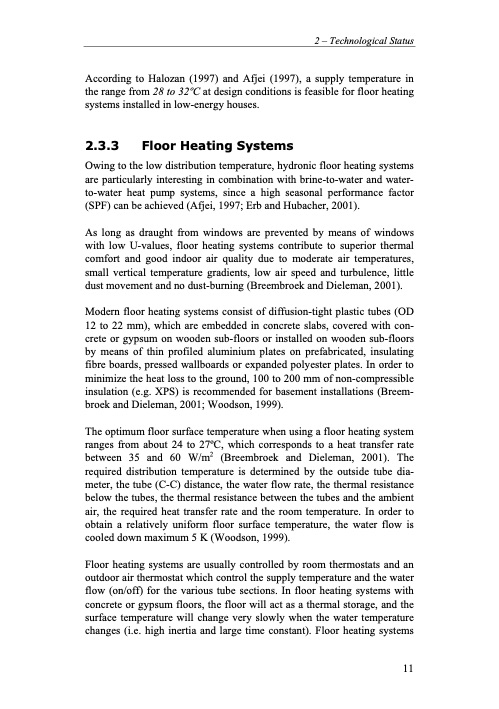
PDF Publication Title:
Text from PDF Page: 033
According to Halozan (1997) and Afjei (1997), a supply temperature in the range from 28 to 32oC at design conditions is feasible for floor heating systems installed in low-energy houses. 2.3.3 Floor Heating Systems Owing to the low distribution temperature, hydronic floor heating systems are particularly interesting in combination with brine-to-water and water- to-water heat pump systems, since a high seasonal performance factor (SPF) can be achieved (Afjei, 1997; Erb and Hubacher, 2001). As long as draught from windows are prevented by means of windows with low U-values, floor heating systems contribute to superior thermal comfort and good indoor air quality due to moderate air temperatures, small vertical temperature gradients, low air speed and turbulence, little dust movement and no dust-burning (Breembroek and Dieleman, 2001). Modern floor heating systems consist of diffusion-tight plastic tubes (OD 12 to 22 mm), which are embedded in concrete slabs, covered with con- crete or gypsum on wooden sub-floors or installed on wooden sub-floors by means of thin profiled aluminium plates on prefabricated, insulating fibre boards, pressed wallboards or expanded polyester plates. In order to minimize the heat loss to the ground, 100 to 200 mm of non-compressible insulation (e.g. XPS) is recommended for basement installations (Breem- broek and Dieleman, 2001; Woodson, 1999). The optimum floor surface temperature when using a floor heating system ranges from about 24 to 27oC, which corresponds to a heat transfer rate between 35 and 60 W/m2 (Breembroek and Dieleman, 2001). The required distribution temperature is determined by the outside tube dia- meter, the tube (C-C) distance, the water flow rate, the thermal resistance below the tubes, the thermal resistance between the tubes and the ambient air, the required heat transfer rate and the room temperature. In order to obtain a relatively uniform floor surface temperature, the water flow is cooled down maximum 5 K (Woodson, 1999). Floor heating systems are usually controlled by room thermostats and an outdoor air thermostat which control the supply temperature and the water flow (on/off) for the various tube sections. In floor heating systems with concrete or gypsum floors, the floor will act as a thermal storage, and the surface temperature will change very slowly when the water temperature changes (i.e. high inertia and large time constant). Floor heating systems 2 – Technological Status 11PDF Image | Residential CO2 Heat Pump System for Combined

PDF Search Title:
Residential CO2 Heat Pump System for CombinedOriginal File Name Searched:
20559406.pdfDIY PDF Search: Google It | Yahoo | Bing
CO2 Organic Rankine Cycle Experimenter Platform The supercritical CO2 phase change system is both a heat pump and organic rankine cycle which can be used for those purposes and as a supercritical extractor for advanced subcritical and supercritical extraction technology. Uses include producing nanoparticles, precious metal CO2 extraction, lithium battery recycling, and other applications... More Info
Heat Pumps CO2 ORC Heat Pump System Platform More Info
| CONTACT TEL: 608-238-6001 Email: greg@infinityturbine.com | RSS | AMP |